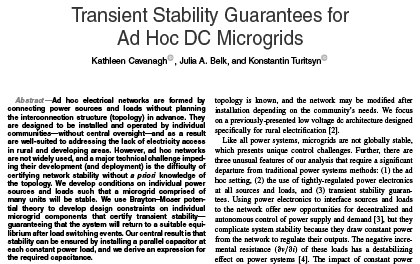We have established a lower bound on load capacitance which can guarantee network stability without pre-determining the network topology. Our bound provides a theoretical foundation for ad hoc microgrids with modular source and load units. The development process for these microgrids is 1) Define acceptable voltage levels across all units based on converter constraints: nominal voltage V0. minimal acceptable equilibrium voltage Vmin. minimum acceptable voltage during switching transients Vtr. 2) Select system parameters: the upper bound on system loading Pmax and the maximum line resistance Rmax (determined by line material. diameter and length). 3) For each load κ with maximum power pmax κ . select a capacitance that ensures stability according to the constraints in Figure 3. This process is independent of the network topology and therefore it does not need to be repeated for each community. Instead. it can be performed once to develop. for example. electricity access “kits“ that could be produced in bulk and easily adapted to the changing needs of individual communities without oversight. Several exciting paths needs to be further explored. These include the generalization of the results to restricted topologies. more detailed load and source models. Similarly. more research is required to understand how stability can be enforced on secondary control loops on sources in the presence of inductive delays.

 Iran Energy News Oil, Gas, Petrochemical and Energy Field Specialized Channel
Iran Energy News Oil, Gas, Petrochemical and Energy Field Specialized Channel



